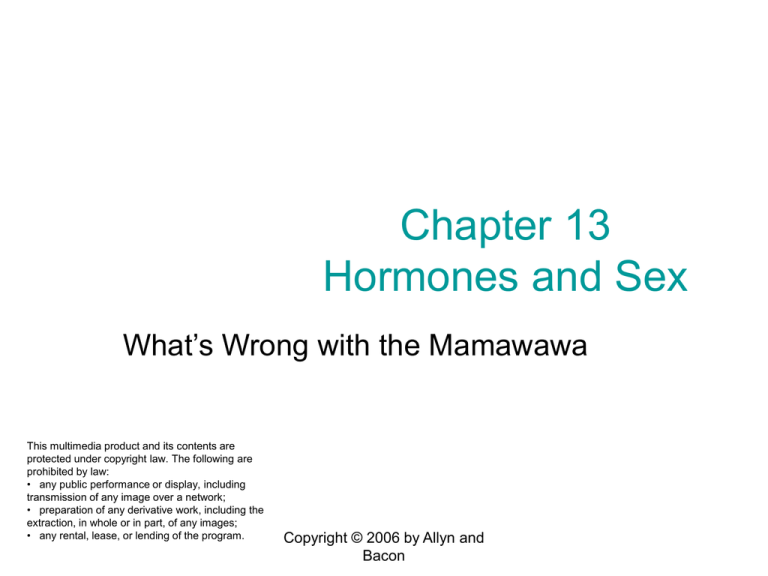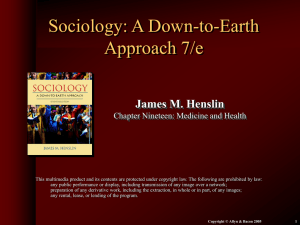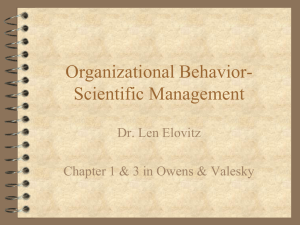
Chapter 13
Hormones and Sex
What’s Wrong with the Mamawawa
This multimedia product and its contents are
protected under copyright law. The following are
prohibited by law:
• any public performance or display, including
transmission of any image over a network;
• preparation of any derivative work, including the
extraction, in whole or in part, of any images;
• any rental, lease, or lending of the program.
Copyright © 2006 by Allyn and
Bacon
Developmental and Activational
Effects of Sex Hormones
• Developmental – “organizational” influencing the development of
anatomical, physiological and
behavioral characteristics that
differentiate the sexes
• Activational – activating reproductionrelated behavior in mature individuals
Copyright © 2006 by Allyn and
Bacon
Glands
• Exocrine – Release chemicals into ducts which
carry them to their targets.
– Sweat glands, for example.
• Endocrine – Ductless. Release hormones
directly into the circulatory system.
– Only organs whose primary function is hormone
release are referred to as endocrine glands.
Copyright © 2006 by Allyn and
Bacon
Hormones
• Amino acid derivatives
– Epinephrine, for example (adrenal medulla)
• Peptides and proteins
– Short and long chains of amino acids
• Steroids
– Synthesized from cholesterol (fat)
– Fat-soluble – able to enter cells and bind to receptors
in cytoplasm or nucleus
Copyright © 2006 by Allyn and
Bacon
Gonads
• Male testes produce sperm cells
• Female ovaries produce ova
– Sperm and ova each have 23 chromosomes
• Fertilization
– Sperm cell + ovum = zygote
– 23 pairs of chromosomes
• X and Y – sex chromosomes
– XX = female, XY = male
Copyright © 2006 by Allyn and
Bacon
Sex Steroids – Released by
Gonads
• Androgens - e.g., testosterone
• Estrogens - e.g., estradiol
• Adult testes release more androgens and ovaries more
estrogens
• Progestins – also present in both sexes
– progesterone prepares uterus and breasts for pregnancy
• Adrenal cortex – also releases sex steroids
Copyright © 2006 by Allyn and
Bacon
Hormones of the Pituitary
• “Master gland”
• Tropic hormones influence the release of
hormones by other glands
• Posterior pituitary – hormones synthesized
in the hypothalamus
• Anterior pituitary – tropic hormones
Copyright © 2006 by Allyn and
Bacon
Sexual Development
• We are dimorphic – exist in 2 forms
• Initially there is a primordial gonad
– Cortex – potential to be ovary
– Medulla – potential to be a testis
• If XY, Y triggers the synthesis of H-Y antigen and
promotes development of the medulla
• No H-Y antigen, cortex develops into ovary
Copyright © 2006 by Allyn and
Bacon
Copyright © 2006 by Allyn and
Bacon
Sexual Development
• 6-weeks post-conception:
– H-Y antigen > testes
– No H-Y antigen > ovaries
• Both sexes begin with 2 sets of reproductive ducts
– Wolffian system – male – seminal vesicles, vas deferens
– Mullerian system – female – uterus, vagina, fallopian tubes
• Differentiation occurs in the 3rd prenatal month
Copyright © 2006 by Allyn and
Bacon
Sexual Development
• 6-weeks: gonads develop
• 3rd prenatal month: differentiation of ducts
– Testes produce testosterone and Mullerian-inhibiting
substance
• Wolffian system develops, Mullerian degenerates, testes
descend
– No testes – no testicular hormones
• Mullerian system develops, Wolffian degenerates
Copyright © 2006 by Allyn and
Bacon
Copyright © 2006 by Allyn and
Bacon
A terminology note
• Ovariectomy – removal of ovaries
• Orchidectomy – removal of testes
• Gonadectomy or castration – removal of
gonads, either ovaries or testes
• Such procedures are often used to study
the effects of sex hormones
Copyright © 2006 by Allyn and
Bacon
Sexual Development
• External reproductive structures – genitalia
– develop from one bipotential precursor
• Differentiation occurs in 2nd month
• Testosterone > male
• No testosterone > female
Copyright © 2006 by Allyn and
Bacon
Copyright © 2006 by Allyn and
Bacon
Sexual Dimorphisms in the Brain
• Pfeiffer (1936) – gonadectomized and implanted
gonads in neonatal rats
– Gonadectomy > cyclic hormone release
– Transplant of testes or ovaries > steady
• Perinatal hormones lead to male pattern
• Why do both ovaries and testes lead to male
pattern?
• What masculinizes the brain?
Copyright © 2006 by Allyn and
Bacon
Sexual Dimorphisms in the Brain
• What masculinizes the brain?
• Sex steroids are all derived from
cholesterol and are readily converted from
one to the other
– Aromatize testosterone > estradiol
• Evidence suggests that estradiol
masculinizes the brain
Copyright © 2006 by Allyn and
Bacon
Evidence that Estradiol (E)
Masculinizes the Neonatal Brain
• Neonatal injections of E masculinize
• Dihydrotestosterone can’t be converted to E –
doesn’t masculinize
• Block aromatization or E receptors – interferes
with masculinizing effects of testosterone
• Why doesn’t E masculinize female brains?
Copyright © 2006 by Allyn and
Bacon
Alpha fetoprotein
• In blood during perinatal period - protects
the female brain from E
• Binds to circulating E, so none gets to the
brain
• How does E get into male brain?
• In males, testoterone enters the brain and
then is converted to E
Copyright © 2006 by Allyn and
Bacon
Sexual Dimorphisms
• Not just a consequence of absence or presence
of testosterone (T)
– XX and XY cells differ prior to hormone exposure
– Female brain development may not automatically
occur in absence of T
– Various dimorphisms emerge at different stages
under different influences
Copyright © 2006 by Allyn and
Bacon
Perinatal Hormones and Behavioral
Development
• Masculinize – promoting male behavior,
mounting, etc.
• Defeminize – preventing female behavior,
lordosis
• Perinatal T masculinizes and defeminizes
• Neonatal castration of male rats – feminizes and
demasculinizes
Copyright © 2006 by Allyn and
Bacon
Puberty
• Fertility achieved, secondary sex characteristics
develop
– Features that distinguish sexually mature men and
women
• Increase in release of anterior pituitary
hormones
– Growth hormone – acts on bone and muscle
– Gonadoptrophic hormone
– Adrenocorticotrophic hormone
Copyright © 2006 by Allyn and
Bacon
Copyright © 2006 by Allyn and
Bacon
Puberty
• Relative levels of androgens and
estrogens determine whether male or
female features develop
• Androstenedione – androgen necessary
for the growth of axillary and pubic hair in
both sexes
Copyright © 2006 by Allyn and
Bacon
Andrenogenital Syndrome
• Androgenic insensitivity leads an XY individual to look
female (Anne S.)
• Andrenogenital Syndrome is caused by congenital
adrenal hyperplasia
– Too little cortisol leads to compensatory excessive release of
adrenal androgens
– No problem for males
– May masculinize female genitalia and behavior – surgical and
hormonal treatments needed at puberty
Copyright © 2006 by Allyn and
Bacon
Male Reproduction-Related
Behavior and Testosterone (T)
• Effects of orchidectomy Bremer (1959)
– Reduced sexual interest and behavior
– Rate and degree of loss varies
– Still have adrenal T
• Level of male sexuality is NOT correlated with T
levels
• Increasing male T levels does NOT increase sex
drive
Copyright © 2006 by Allyn and
Bacon
Female Reproduction-Related
Behavior and Gonadal Hormones
• Rats and guinea pigs – surges of estrogen and
progesterone initiate estrus, a period of fertility
and receptivity
• Women – sexual motivation and behavior not
tied to cycle
• Sex drive may be under androgenic control
Copyright © 2006 by Allyn and
Bacon
Human Female Sexuality and
Androgens
• T increases the proceptivity of ovariectomized
and adrenalectomized female rhesus monkeys
• Correlations seen between sexual motivation
and T
• T found to rekindle sexual motivation in
ovariectomized and adrenalectomized women
Copyright © 2006 by Allyn and
Bacon
Anabolic Steroids
• Anabolic – growth-promoting
• No firm scientific evidence that muscularity and strength
are increased
• Sex-related side effects
• High circulating hormones cause a reduction of natural
release
– Men - testicular atrophy, sterility, gynecomastia (breast growth in
men)
– Women – amenorrhea (cessation of menstruation), sterility,
hirsutism (excessive growth of body hair)
Copyright © 2006 by Allyn and
Bacon
Neural Mechanisms of Sexual
Behavior
• Sexually dimorphic nucleus (SDN)
– medial preoptic area of rat hypothalamus
– larger in males, due to estradiol shortly after birth
– size of male SDN correlated with T levels and aspects
of sexual activity
• Nuclei in preoptic, suprachiasmatic, and anterior
regions of the hypothalamus are larger in men
than in women
Copyright © 2006 by Allyn and
Bacon
Medial Preoptic Area of the
Hypothalamus
• Contains the SDN
• Destruction abolishes sexual behavior of
all mammalian males studied, but does not
affect female sexual behaviors females
• Stimulation elicits copulatory behaviors
Copyright © 2006 by Allyn and
Bacon
Ventromedial Nucleus of the
Hypothalamus
• Contains circuits critical for female rat
sexual behavior
• Lesion eliminates lordosis
• Microinjections of E and progesterone
induce estrus
• Lesions of periaqueductal gray (PAG) or
the tracts to it eliminate lordosis
Copyright © 2006 by Allyn and
Bacon










